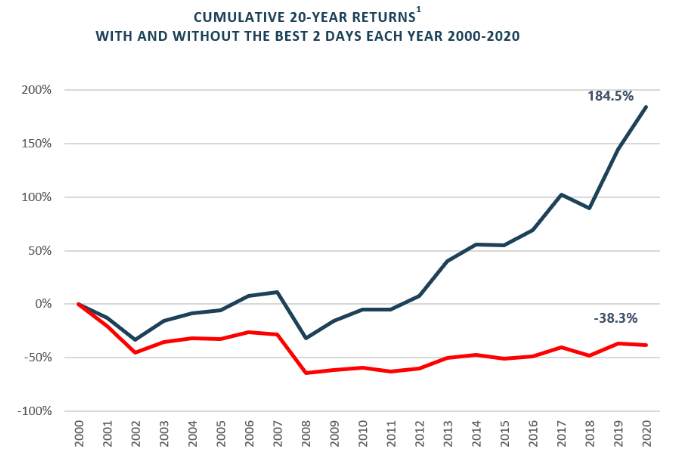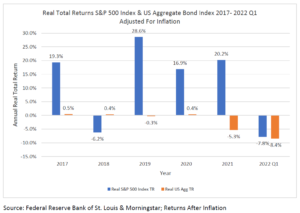Being the steady hand for your clients is part of the additive value of being an advisor.
You’ve been through the ups and downs of markets. You know how to ride out the dips, but your clients may panic at the very inopportune times. Worse, they tend to sell at the wrong time and miss out while waiting to get back in.
You know they need to stay invested as missing even the best 2 days each year significantly negatively impacts investment returns.
 Source: Morningstar – S&P 500 Index price data. The data does not reflect dividends.
Source: Morningstar – S&P 500 Index price data. The data does not reflect dividends.
The chart represents the cumulative return over 20 years utilizing daily data from Morningstar of the S&P 500 Index price change only (excluding dividends) where we took out the two highest daily price returns for each year and calculated the annual price change from the remaining days. The chart shows the cumulative running return comparing the percent change with all days included vs. removing the two highest price return days each year.
Past performance is not guarantee of future results. Index performance does not reflect fees. Once cannot invest directly in an index.
Hedged Equity Strategy That Allows Clients to Stay Invested
You can help your clients by offering a strategy that seeks long-term capital appreciation while mitigating overall market risk.
Plus, if markets go down enough it opens the opportunity to reinvest avoided losses at lower price levels in markets. Given inflation you understand the importance of growing assets. You value helping clients reduce their anxiety and panic in uncertain times.
If 2022 has taught us anything it’s the old 60/40 portfolios have thus far offered little reprieve in a rising rate environment.
Click here for more information on ZEGA’s Buy & Hedge ETF
Investors should consider the investment objectives, risks, charges and expenses carefully before investing. For a prospectus or summary prospectus with this and other information about the Fund, click here. For the Fund’s Top 10 Holdings, please click here. Read the prospectus or summary prospectus carefully before investing.
FUND RISKS:
Equity Market Risk. The equity securities underlying the Fund’s option investments may experience sudden, unpredictable drops in value or long periods of decline in value.
Derivatives Risk. The Fund invests in options, which are a form of derivative investment. Derivatives have risks, including the imperfect correlation between the value of such instruments and the underlying assets or index; the loss of principal, including the potential loss of amounts greater than the initial amount invested in the derivative instrument; and illiquidity of the derivative investments. The derivatives used by the Fund may give rise to a form of leverage. Leverage magnifies the potential for gain and the risk of loss.
As with all ETFs, Shares may be bought and sold in the secondary market at market prices. Although it is expected that the market price of Shares will approximate the Fund’s NAV, there may be times when the market price of Shares is more than the NAV intra-day (premium) or less than the NAV intra-day (discount) due to supply and demand of Shares or during periods of market volatility.
The Fund may invest in fixed income securities directly or through ETFs or other investment companies. Fixed income securities are subject to interest rate risk (discussed further herein), call risk, prepayment and extension risk, credit risk (discussed further herein), and liquidity risk. Interest rates may go up resulting in a decrease in the value of the fixed income securities held by the Fund. Credit risk is the risk that an issuer will not make timely payments of principal and interest. Because the Fund is “non-diversified,” it may invest a greater percentage of its assets in the securities of a single issuer or a smaller number of issuers than if it was a diversified fund. As a result, a decline in the value of an investment in a single issuer or a smaller number of issuers could cause the Fund’s overall value to decline to a greater degree than if the Fund held a more diversified portfolio.
References to other securities is not an offer to buy or sell.
New Fund Risk. The Fund is a recently organized management investment company with no operating history.
The fund is distributed by Foreside Fund Services, LLC.
Launch & Structure Partner: Tidal ETF Services



